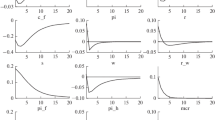Abstract
In this paper, we formulate a Kaldorian business-cycle model in a small open economy. We consider the possibility of capital mobility, and both the system of fixed exchange rates and that of flexible exchange rates are studied. We investigate how changes of the parameter which represents the “degree of capital mobility” affect the dynamic characteristics of the model. Some numerical simulations are performed based on the analytical model.
Similar content being viewed by others
References
Asada, T. (1987): “Government Finance and Wealth Effect in a Kaldorian Cycle Model.”Journal of Economics/Zeitschrift für Nationalökonomie 47: 143–166.
— (1991): “On a Mixed Competitive-Monopolistic Macrodynamic Model in a Monetary Economy.”Journal of Economics/Zeitschrift für Nationalökonomie 54: 33–53.
Asada, T., and Semmler, W. (1995): “Growth and Finance: an Intertemporal Model.”Journal of Macroeconomics 17: 623–649.
Benhabib, J., and Miyao, T. (1981): “Some New Results on the Dynamics of the Generalized Tobin Model.”International Economic Review 22: 589–596.
Benhabib, J., and Nishimura, K. (1979): “The Hopf Bifurcation and the Existence and Stability of Closed Orbits in Multisector Models of Optimal Economic Growth.”Journal of Economic Theory 21: 421–444.
Chang, W., and Smyth, D. (1971): “The Existence and Persistence of Cycles in a Nonlinear Model: Kaldor's 1940 Model Re-Examined.”Review of Economic Studies 38: 37–44.
Chiarella, C. (1990): “Excessive Exchange Rate Variability: a Possible Explanation Using Nonlinear Economic Dynamics.”European Journal of Political Economy 6: 315–352.
Dornbusch, R. (1976): “Expectations and Exchange Rate Dynamics.”Journal of Political Economy 84: 1161–1176.
Flaschel, P. (1993):Macrodynamics: Income Distribution, Effective Demand, and Cyclical Growth. Bern: Peter Lang.
Fleming, J. M. (1962): “Domestic Financial Policies Under Fixed and Floating Exchange Rates.”IMF Staff Papers 4: 369–380.
Franke, R. (1990): “A Note on Implicit Inventory Behavior in Cyclical Macroeconomic Models with Excess Demand.”Journal of Macroeconomics 12: 625–636.
— (1992): “Stable, Unstable, and Persistent Cyclical Behavior in a Keynes-Wicksell Monetary Growth Model.”Oxford Economic Papers 44: 242–256.
Franke, R., and Asada, T. (1994): “A Keynes-Goodwin Model of the Business Cycle.”Journal of Economic Behavior and Organization 24: 273–295.
Frenkel, J. A., and Razin, R. (1987): “The Mundell-Fleming Model a Quarterly Century Later.”IMF Staff Papers 34: 567–620.
Hamada, K. (1985):The Political Economy of International Monetary Interdependence. Cambridge, MA: MIT Press.
Kaldor, N. (1940): “A Model of the Trade Cycle.”Economic Journal 50: 78–92.
Lorenz, H. W. (1987): “International trade and the Possible Occurrence of Chaos.”Economics Letters 23: 135–138.
— (1993):Nonlinear Dynamical Economics and Chaotic Motion. 2nd ed. Berlin: Springer.
Mundell, R. A. (1968):International Economics. New York: Macmillan.
Sarantis, N. (1989): “Macroeconomic Policy and Activity in an Open Economy with Oligopoly and Collective Bargaining.”Journal of Economics/Zeitschrift für Nationalökonomie 49: 25–46.
— (1991): “Distribution and Terms of Trade Dynamics, Inflation, and Growth.”Journal of Post Keynesian Economics 13: 175–198.
Semmler, W. (1986): “On Nonlinear Theories of Cycles and the Persistence of Business Cycles.”Mathematical Social Sciences 12: 47–76.
Sethi, R. (1992): “Endogenous Growth Cycles in an Open Economy with Fixed Exchange Rates.”Journal of Economic Behavior and Organization 19: 327–342.
Torre, V. (1977): “Existence of Limit Cycles and Control in Complete Keynesian System by Theory of Bifurcations.”Econometrica 45: 1457–1466.
Turnovsky, S. (1977):Macroeconomic Analysis and Stabilization Policy. Cambridge: Cambridge University Press.
Varian, H. (1979): “Catastrophe Theory and Business Cycle.”Economic Inquiry 17: 14–28.
Zhang, W. B. (1990): “The Complexity of Nonlinear Dynamic Economic Systems: the Kaldorian Model with Bond Finance of Government.”Journal of Mathematical Sociology 15: 259–269.
Author information
Authors and Affiliations
Rights and permissions
About this article
Cite this article
Asada, T. Kaldorian dynamics in an open economy. Zeitschr. f. Nationalökonomie 62, 239–269 (1995). https://doi.org/10.1007/BF01238819
Received:
Revised:
Issue Date:
DOI: https://doi.org/10.1007/BF01238819




